June 1, 2025 | 06:44 GMT +7
June 1, 2025 | 06:44 GMT +7
Hotline: 0913.378.918
June 1, 2025 | 06:44 GMT +7
Hotline: 0913.378.918
At the beginning of 2022, the People's Committee of Binh Dinh Province has approved a framework project on the conservation of genetic resources in the province by 2025. Accordingly, specializing agencies will apply the scientific technology in preserving genetic resources of some indigenous plant varieties such as upland rice, sticky rice, sticky corn, and sweet cassava, associated with economic development for rural women and ethnic minorities in the province.
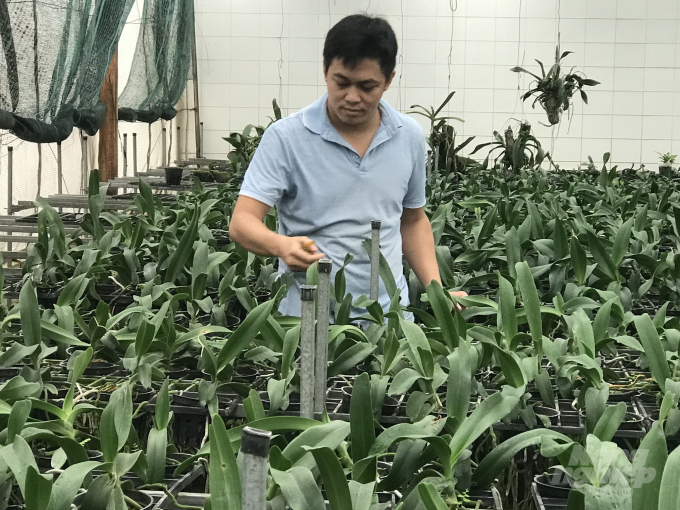
Mr. Le Duc Dung, Deputy Head of the Vegetables and Ornamental Plants Faculty (Agricultural Science Institute for Southern Coastal Central of Vietnam) in a garden of tissue-transplanted orchids. Photo: V.D.T.
Nature favors Binh Dinh with the richness and diversity of plants and animals including many rare and endemic species, especially plant genetic resources. For example, An Toan Nature Reserve in An Toan Commune, An Lao District, is inhabiting 547 species of high-level vascular plants belonging to 304 genera and 110 families; 300 animal species of 89 families and 28 orders of 4 classes of mammals, birds, reptiles, and amphibians.
In particular, among them, there are 10 species of plants and 72 species of rare and endangered animals listed in the Red Book of Vietnam. Moreover, in the Toan Nature Reserve are living 4 plant and 14 animal endemic species. In An Lao, there are also 2 species of precious orchids growing naturally in the forest.
However, the exploitation of natural resources in a form of "extinction" has seriously damaged biodiversity, causing degradation and decline for rare and precious flora and fauna species there. This has led to an ecological imbalance with a worry to gradually lose some rare genetic resources of plants and animals. In addition, climate change impacts have also contributed to making some rare animal species in danger of extinction. Indigenous plant varieties with precious genetic resources are also degraded or at risk of being "lost" in the wild nature.
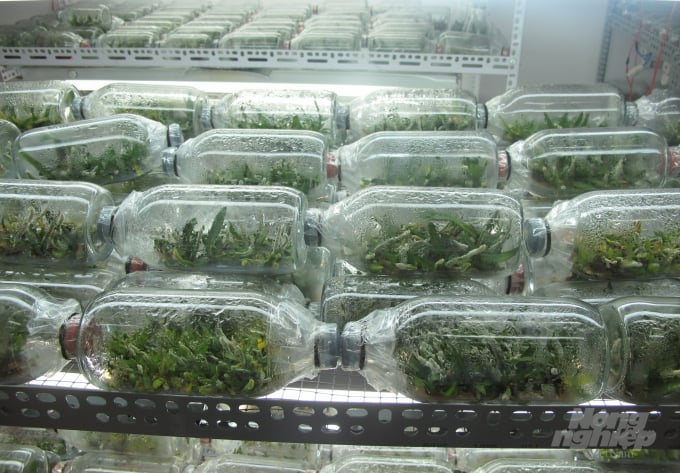
The dai chau (Rhynchostylis gigantea) orchid species is being tissue cultured. Photo: V.D.T.
To cope with that situation, the People's Committee of Binh Dinh has developed a framework project for the conservation of genetic resources in the province by 2025. The project aims to preserve 56 genetic resources of some special plant and microorganism species in the area, collect and evaluate the conservation status of 50 microbial and 6 endemic plant genetic resources. It also targets to identify ecological and environmental conditions affecting the growth and development of such genetic resources, at the same time, build conservation models and propose measures to protect and develop them.
In 2022, Binh Dinh will conduct genetic conservation for some indigenous plant varieties such as upland rice, sticky rice, sticky corn and sweet casava, associated with economic development for rural women and ethnic minorities. In 2023, it will continue to conserve the the nipa palm genetic resources so that to restore mangrove forests for eco-tourism and to deal with climate change.
“As it has been planned, Binh Dinh will preserve 6 genetic resources of some typical local plant and flower varieties, including dry rice varies of Ta Bul, Ba Bak, Ba Trang, and H'Ngok; glutinous corn, pure Ngu sticky rice, sweet casava and water coconut and dai chau orchids," said Dr. Le Cong Nhuong.
A pioneering unit in genetic conservation of dai chau orchids
The Agricultural Sciences Institute for Southern Coastal Central of Vietnam (ASISOV), a unit based in Binh Dinh Province, has recently, applied tissue transplant technology to preserve the genetic resources of rare and precious dai chau orchid (with scientific name as Rhynchostylis gigantea) that grows naturally in An Lao forest, Binh Dinh Province.
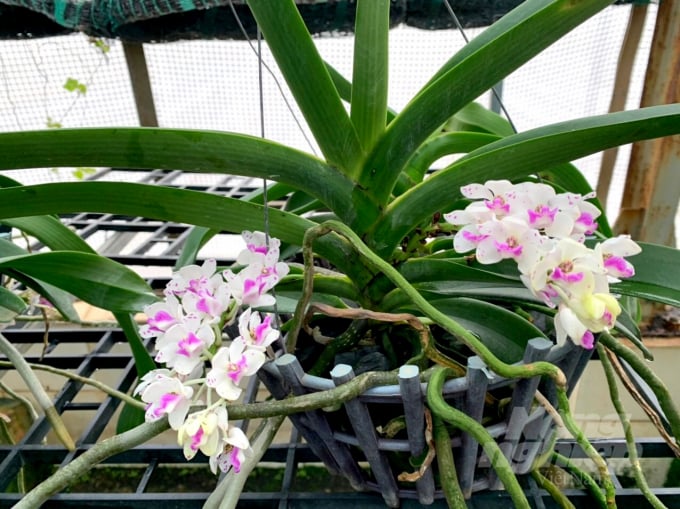
Dai chau orchid flowers are blooming right in the Tet (Lunar New Year). Photo: V.D.T.
According to Dr. Vu Van Khue, ASISOV Deputy Director, the dai chau orchids are distributed in the high mountains from over 600m above sea level. It is now very popular in the market.
In the past, there were many orchids in the forest. Every year, in the 10th lunar month of the rainy season, the orchid seeds split into the forest and dispersed in the air but were hard to germinate under normal conditions. The germination rate in the wild was very low. If people brought seeds to nurse in normal conditions, the seeds could not germinate.
“Therefore, a research team from the Vegetables and Ornamental Trees of the ASISOV have collected the fruit, separated for seeds and then applied tissue-culture technology to preserve and develop that precious orchid lineage,” said Dr. Khue.
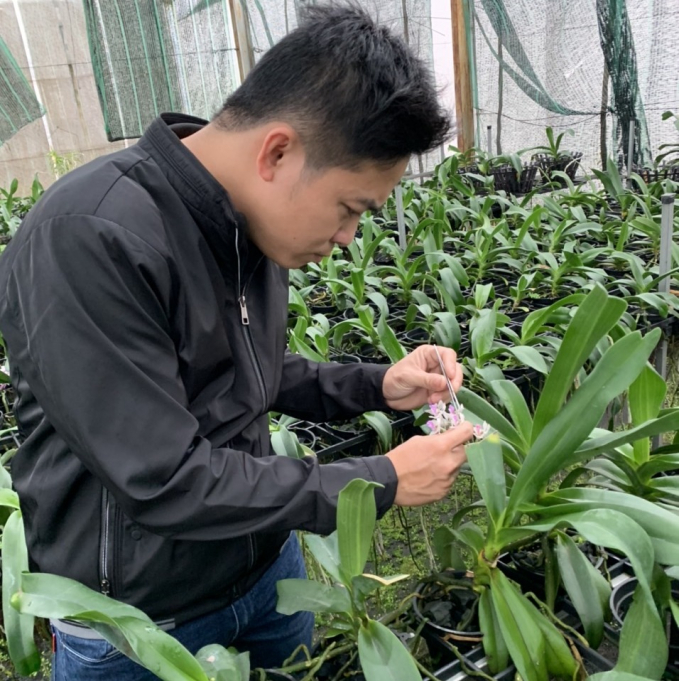
Mr. Le Duc Dung, Deputy Head of the Vegetables and Ornamental Trees Faculty of the ASISOV is pollinating to get seeds of dai chau orchid. Photo: V.D.T.
According to Mr. Le Duc Dung, Deputy Head of the Vegetables and Ornamental Trees Faculty of the ASISOV, the faculty has applied tissue culture technology to conserve genetic resources and develop dai chau orchid lines for 4 years now. When the seeds of orchids in nature are exhausted, the Faculty will select the tops, leaves, buds, or stems of healthy orchids that have self-pollinated flowers to propagate. It will also apply tissue culture technology to continue to multiply them.
The dai chau orchid is now almost "absent" in the wild due to over-exploitation thus an orchid plant cut down from the forest may cost up to VND2 million. Meanwhile, orchids grown by the ASISOV are only sold for VND300,000/plant.
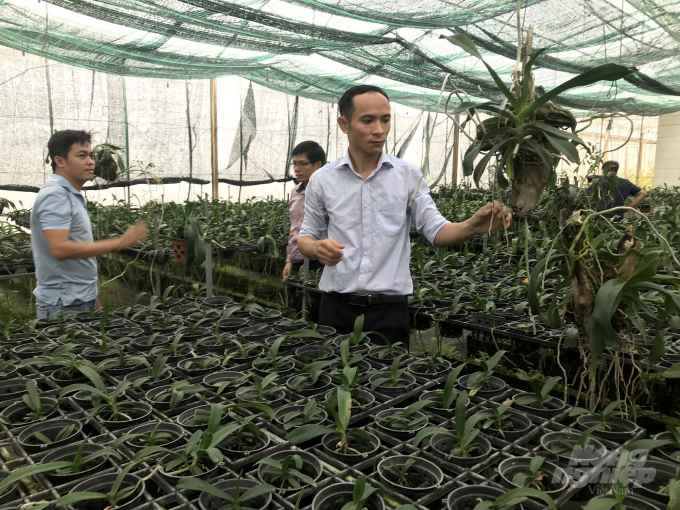
Leaders of the Vegetables and Ornamental Trees Faculty are taking care of the dai chau orchid garden. Photo: V.D.T.
“The main aim of applying the tissue culture technology in growing dai chau orchids is to conserve genetic resources and develop a rare orchid line. From the institute’s available orchid resources, in the coming time, we will choose the best plants, give the most beautiful flowers to raise for seeds, then apply tissue culture technology to continue multiplying them to provide to market…," said Dr. Vu Van Khue, Deputy Director of the ASISOV.
In the project on conservation of genetic resources of Binh Dinh province by 2025, the ASISOV was assigned by the provincial People's Committee as a premier unit in conserving, exploiting and developing genetic resources of some indigenous plant varieties such as upland rice, sticky rice, sticky corn and sweet cassava. The Institute is also assigned by the Committee in preserving and developing the An Lao dai chau orchid.
Translated by Linh Nguyen

(VAN) Several scientists and farmers are experimenting with soil treatment in some key durian-growing regions such as Cai Lay (Tien Giang), Dak Song, Gia Nghia, and Dak R’lap (Dak Nong).
/2025/05/25/4127-3-073637_820.jpg)
(VAN) Thanks to the promotion from an FAO-implemented project, vegetable production in greenhouses in Moc Chau has seen strong development, from 1.5 hectares in 2021 to nearly 50 hectares in 2024.

(VAN) FAO has recently supported USD 140,000 to implement the project 'Risk mitigation human-animal interface risks through disease control initiatives in pig farming.'

(VAN) The People's Committee of Tra Vinh province has approved an adjustment to the investment policy for the Green Hydrogen Plant project, increasing its area to approximately 52.76 hectares.
![Reducing emissions from rice fields: [2] Farmers’ commitment to the soil](https://t.ex-cdn.com/nongnghiepmoitruong.vn/608w/files/news/2025/05/05/dsc08881jpg-nongnghiep-140632.jpg)
(VAN) Clean rice cultivation model in Thuong Tan commune, Bac Tan Uyen district, is assisting local residents in achieving sustainable agriculture by substantially reducing costs, increasing productivity, and protecting the environment.

(VAN) At the conference to disseminate Resolution No. 68, AgriS introduced its digital agricultural ecosystem and reaffirmed its commitment to accompanying the Government in promoting private sector development and sustainable agriculture.

(VAN) 'Blue Ocean - Blue Foods' initiative is designed to restore marine ecosystems and establish sustainable livelihoods for local communities by cultivating a minimum of 1,000 hectares of cottonii seaweed in the first three years.